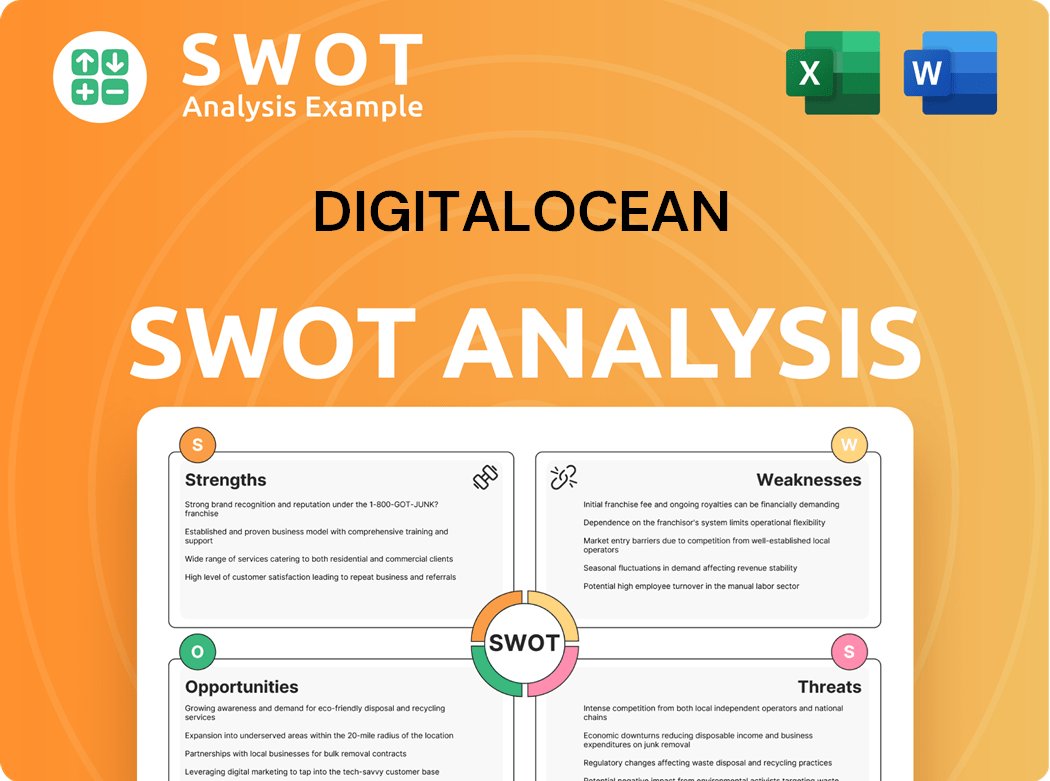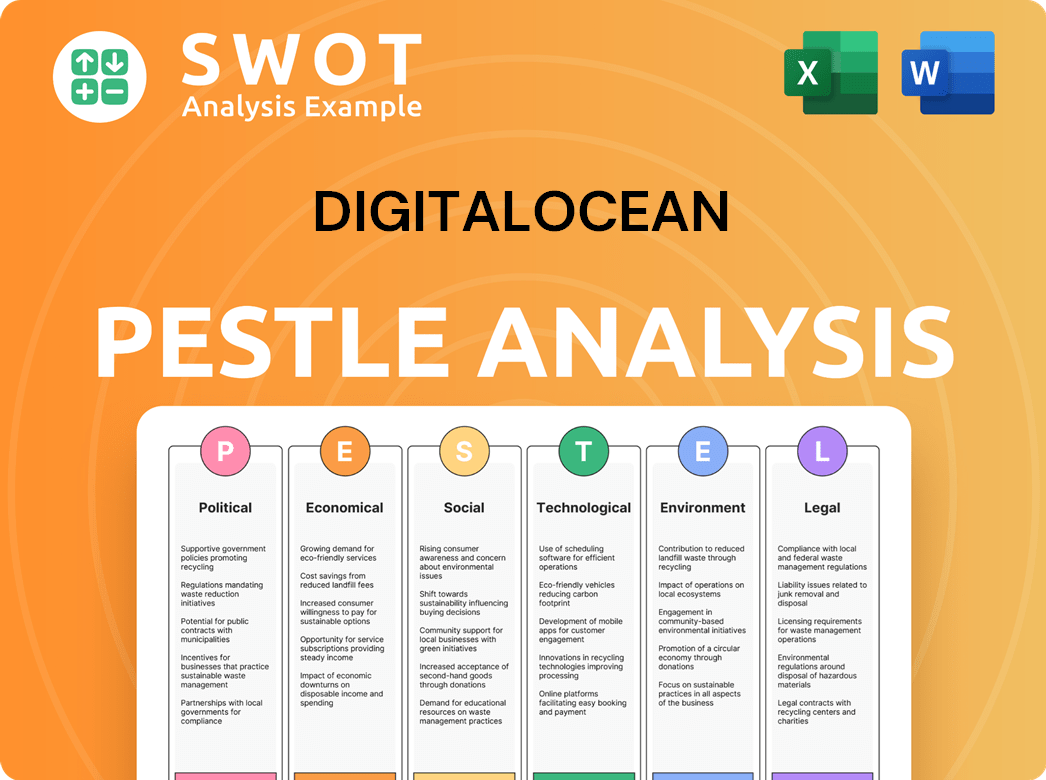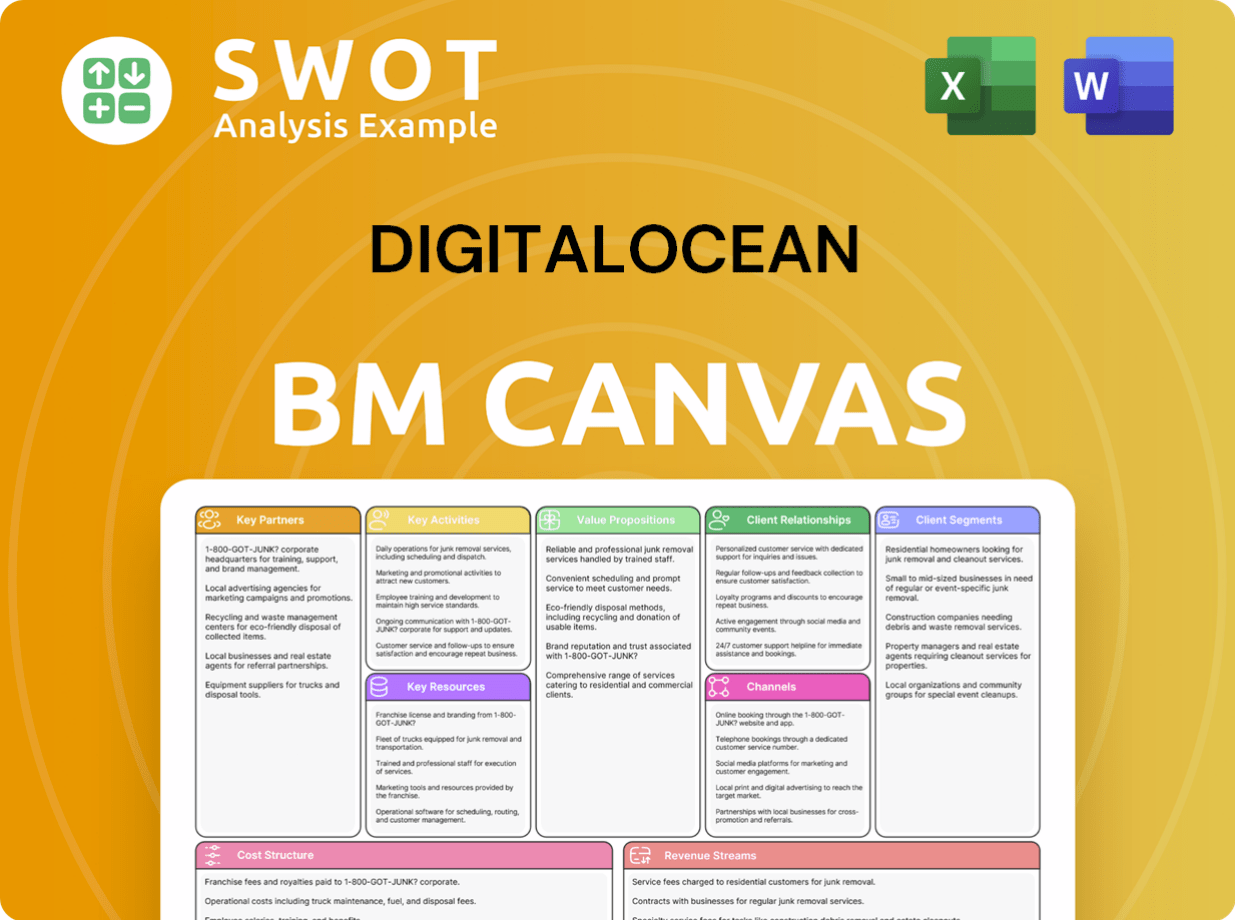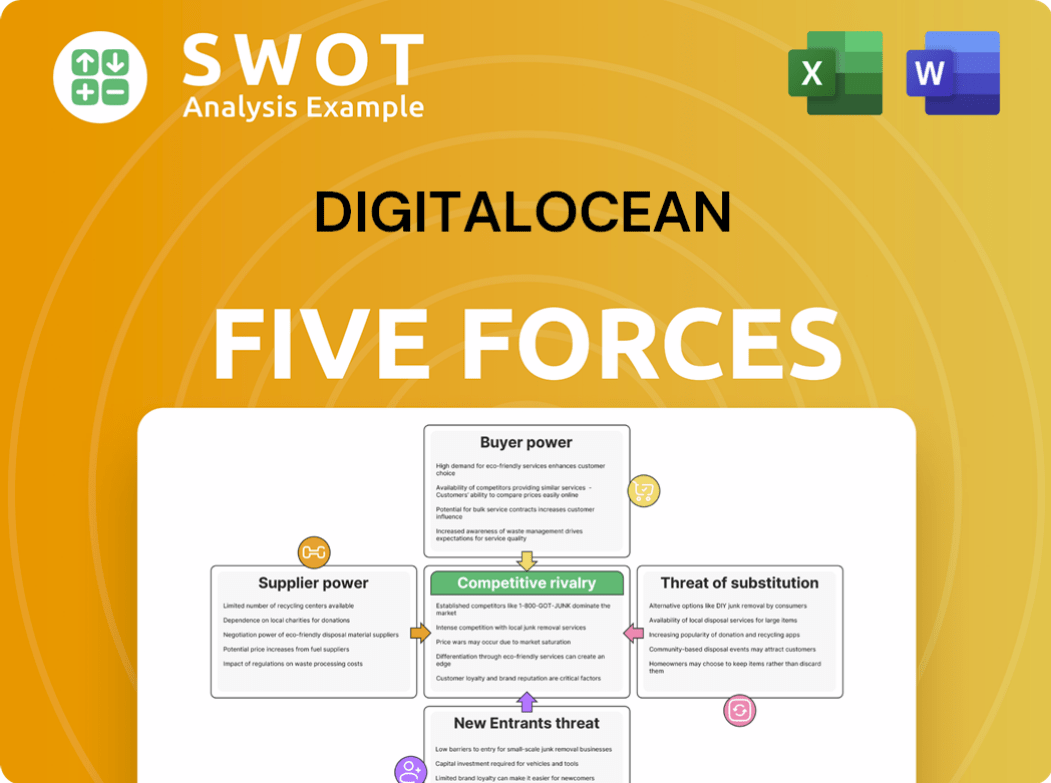DigitalOcean Bundle
How Has DigitalOcean Mastered Cloud Computing Sales and Marketing?
DigitalOcean, a cloud computing provider, has dramatically evolved its sales and marketing strategies since its 2011 launch. Initially focused on developer-friendly simplicity, the company has consistently emphasized approachability in a complex market. This approach has fueled impressive growth, as demonstrated by its recent financial performance.

This article will explore DigitalOcean's DigitalOcean SWOT Analysis to understand its strategic moves, from its initial focus on developers to its current targeting of Digital Native Enterprises. We'll dissect its DigitalOcean sales strategy, including its customer acquisition strategies and sales funnel optimization, along with its DigitalOcean marketing strategy, examining its content marketing examples and SEO strategy review. You'll gain insights into how DigitalOcean leverages its cloud computing marketing, SaaS sales tactics, and digital infrastructure to maintain its competitive edge in the cloud market.
How Does DigitalOcean Reach Its Customers?
The sales channels of DigitalOcean are multifaceted, primarily leveraging online platforms and direct sales to connect with its target audience of developers, startups, and small to medium-sized businesses. The company's website serves as a central e-commerce hub for direct sales of its cloud computing services, including virtual machines and databases. This direct-to-customer (DTC) approach has been crucial to its original go-to-market strategy, emphasizing ease of use and self-service for developers. The Growth Strategy of DigitalOcean is heavily influenced by these core sales methods.
DigitalOcean has strategically evolved its sales channels, focusing on product-led sales and investing in customer-facing teams to support workload migrations. This shift has enabled the company to expand relationships with larger accounts and increase revenue from higher-spending customers. The company’s focus on enhancing its sales strategies has been instrumental in driving revenue growth and market share expansion.
Key partnerships and exclusive distribution deals play a significant role in DigitalOcean's growth and market share expansion, with the DigitalOcean Partner Program providing various collaboration pathways. These strategic alliances contribute to growth by expanding DigitalOcean's reach into new markets and offering integrated solutions that cater to diverse customer needs.
DigitalOcean primarily utilizes its website as a direct sales channel, enabling customers to purchase cloud computing services directly. This direct-to-customer (DTC) model emphasizes ease of use and self-service, particularly for developers. The company's online platform facilitates the sale of services like virtual machines (Droplets), storage, and databases.
DigitalOcean has enhanced its product-led sales motion by investing in customer-facing teams. These teams support workload migrations and provide assistance to customers. This approach has been successful in driving revenue growth, especially among higher-spending customers.
DigitalOcean actively forms strategic partnerships to expand its reach and offer integrated solutions. The DigitalOcean Partner Program supports collaborations with ISVs, managed service providers, and venture capital funds. Recent partnerships include collaborations with PureDome, Ant Media Server, and Coreflux.
DigitalOcean focuses on expanding relationships with larger accounts. 'Higher Spend Customers,' spending over $50 per month, represented 88% of total revenue and grew 16% year-over-year in Q4 2024. Scalers+ customers (spending $100K+ annually) saw a 41% year-over-year revenue growth in Q1 2025, contributing 23% of total revenue.
DigitalOcean's sales strategy combines direct online sales, product-led growth, and strategic partnerships to reach its target audience. This approach focuses on ease of use, customer support, and expanding market reach through collaborations. The company emphasizes customer acquisition strategies and customer retention techniques to drive growth.
- Direct-to-Customer (DTC) Model: Emphasizes self-service and ease of use via the website.
- Product-Led Growth: Focuses on user experience and product value to drive sales.
- Strategic Partnerships: Collaborations with other companies to expand market reach and offer integrated solutions.
- Customer-Facing Teams: Dedicated teams to support workload migrations and provide customer support.
DigitalOcean SWOT Analysis
- Complete SWOT Breakdown
- Fully Customizable
- Editable in Excel & Word
- Professional Formatting
- Investor-Ready Format

What Marketing Tactics Does DigitalOcean Use?
DigitalOcean's marketing strategy is a multifaceted approach designed to boost brand awareness, generate leads, and drive sales. It heavily relies on digital channels and a data-driven methodology to reach its target audience of developers and businesses. This strategy is crucial for the company's growth, especially in the competitive cloud computing market.
The company's tactics encompass content marketing, paid advertising, email campaigns, and active engagement on social media platforms. DigitalOcean also leverages influencer partnerships to enhance its visibility within the developer community. The focus is on providing value and building relationships with potential and existing customers.
A key element of DigitalOcean's marketing strategy is its data-driven approach, utilizing analytics to refine its strategies, target the right audience, and maximize ROI. This includes personalization to create targeted campaigns and track content performance to refine its content strategy. The company's commitment to innovation is evident in its product releases and community engagement events.
DigitalOcean uses content marketing as a cornerstone, producing high-quality, informative content like blog posts and tutorials. This content is designed to educate and empower its developer-centric audience. The content is optimized for SEO, incorporating relevant keywords and internal links to attract organic traffic.
Paid advertising, including PPC, banner, and social media advertising, is used to target specific audiences effectively. This helps in reaching potential customers who are actively searching for cloud computing solutions or related services. This is a key part of the DigitalOcean marketing strategy.
Email marketing campaigns are streamlined and personalized based on customer preferences and behavior. This approach aims to improve engagement and conversion rates, ensuring that the right messages reach the right audience at the right time. This is a crucial aspect of SaaS sales tactics.
DigitalOcean actively uses social media platforms like Twitter, Facebook, and LinkedIn to share engaging content. They interact with customers, address queries, gather feedback, and promote the brand. This approach helps build a strong online presence and community.
The company partners with influencers to boost brand visibility and credibility within the developer community. These partnerships help in reaching a wider audience and building trust. This is a key component of their DigitalOcean sales strategy.
DigitalOcean leverages analytics and insights to optimize strategies and maximize ROI. This includes tracking content performance and using marketing automation tools. This data-driven approach is central to their DigitalOcean business model.
DigitalOcean's marketing tactics are designed to drive customer acquisition and retention. The company focuses on providing value through content, engaging with its community, and leveraging data to refine its strategies. The company's focus on product innovation is evident, with over 50 new product features released in Q1 2025, significantly more than the releases in Q1 2024. The relaunch of the 'Deploy' conference in 2024 and its continuation in 2025 highlights the company's commitment to community engagement and product releases. For more information on the company's ownership structure, you can read about the Owners & Shareholders of DigitalOcean.
- Content marketing, including blog posts, whitepapers, and video tutorials, forms a core part of the strategy.
- Paid advertising campaigns are used to target specific demographics and interests.
- Email marketing is highly personalized to boost engagement and conversions.
- Social media is used to engage with customers and build brand awareness.
- Data analytics are used to optimize campaigns and measure ROI.
DigitalOcean PESTLE Analysis
- Covers All 6 PESTLE Categories
- No Research Needed – Save Hours of Work
- Built by Experts, Trusted by Consultants
- Instant Download, Ready to Use
- 100% Editable, Fully Customizable

How Is DigitalOcean Positioned in the Market?
The brand positioning of the company focuses on simplicity, scalability, and approachability. This positions them as the 'simplest scalable cloud for growing tech companies,' a key differentiator from larger cloud providers. Their target audience includes developers, startups, and SMBs who value ease of use and transparent pricing. This strategy aims to provide a streamlined cloud infrastructure experience, allowing users to concentrate on software development rather than complex IT management.
The company's brand identity is reflected in its visual identity and tone of voice, emphasizing clear, direct, and developer-centric communication. The company's commitment to simplicity is evident in its user-friendly interface and intuitive tools. The company's strong community, including IT documentation and peer-to-peer support, reinforces its developer-focused approach, assisting businesses with IT challenges.
The company's market position is defined by its niche focus, providing a competitive advantage. While competitors target large enterprises, the company's strategy allows it to thrive in its segment. The company consistently maintains brand consistency across all channels, reinforcing its core values. The company also adapts to consumer sentiment and competitive threats by innovating and expanding its offerings, particularly in AI/ML, to maintain relevance.
The DigitalOcean sales strategy focuses on direct sales and channel partnerships. The company emphasizes a self-service model, allowing customers to easily sign up and manage their cloud infrastructure. They also offer dedicated sales teams for larger customers and partnerships to expand their reach.
The DigitalOcean marketing strategy includes content marketing, SEO, and community engagement. They create valuable content for developers, such as tutorials and documentation, to attract and retain customers. SEO optimization helps them rank well in search results, and community engagement fosters loyalty.
The DigitalOcean business model is based on a pay-as-you-go pricing structure. This model provides flexibility and cost-effectiveness for customers. They offer various cloud services, including virtual machines, storage, and networking, with transparent pricing. To learn more about their target market, you can read the article Target Market of DigitalOcean.
Cloud computing marketing involves strategies to promote cloud services to various audiences. The company uses content marketing, SEO, and social media to reach potential customers. They also focus on highlighting the benefits of cloud computing, such as scalability and cost savings.
The company employs several key strategies and tactics to achieve its goals. These include a focus on customer acquisition, retention, and expansion. They also leverage partnerships and community building to enhance their market position.
- Customer Acquisition: DigitalOcean uses content marketing, SEO, and paid advertising to attract new customers.
- Customer Retention: They focus on providing excellent customer support, a user-friendly platform, and transparent pricing to retain customers.
- Partnerships: Collaborations with technology companies and service providers expand their reach.
- Community Building: The company actively engages with its community through forums, events, and open-source contributions.
DigitalOcean Business Model Canvas
- Complete 9-Block Business Model Canvas
- Effortlessly Communicate Your Business Strategy
- Investor-Ready BMC Format
- 100% Editable and Customizable
- Clear and Structured Layout

What Are DigitalOcean’s Most Notable Campaigns?
DigitalOcean's sales and marketing strategy revolves around key campaigns designed to emphasize its core value proposition: simplicity and developer-centric support. These campaigns aim to attract new customers and strengthen relationships with existing ones. A significant focus is placed on product innovation, particularly in the AI/ML space, to capitalize on growing market demands.
The company's approach includes strategic partnerships and co-marketing initiatives. These collaborations enhance brand visibility and build credibility by associating with leading players in complementary fields. This multi-faceted strategy supports DigitalOcean's growth objectives, focusing on customer acquisition, retention, and expansion into high-growth areas like AI.
The 'Deploy' conference, relaunched in 2024 and continuing in 2025, is a central element of DigitalOcean's marketing efforts. This event showcases new cloud and AI innovations, facilitating community engagement and highlighting customer success stories. It's a multi-channel campaign, including in-person events, virtual sessions, and YouTube replays, designed to attract new customers while strengthening relationships with existing ones.
DigitalOcean aggressively pursues product innovation, particularly in AI/ML offerings. In Q4 2024 alone, the company released over four times as many products and features as in the previous year. This rapid pace continued into Q1 2025 with over 50 new product features. This highlights their commitment to adapting to market demands and maintaining a competitive edge.
A key product launch was the General Availability of GPU Droplets in October 2024, democratizing access to NVIDIA H100 instances for AI workloads. This was followed by the launch of the GenAI Platform on January 22, 2025, designed to simplify the deployment of AI agents and fine-tuning models. These launches are central to the company's AI strategy.
DigitalOcean aims to capitalize on the increasing demand for AI-powered cloud services. The company projects significant growth in its AI/ML business, with revenue expected to increase from $29 million in 2024 to $105 million in 2026. This demonstrates a strategic focus on high-growth areas to drive overall business expansion.
Partnerships are a crucial part of the DigitalOcean sales strategy. The company collaborates with other businesses to offer integrated services and expand its reach. For example, the October 2024 partnership with Hugging Face streamlines AI model setup. The June 2024 partnership with PureDome enhances cybersecurity, and the July 2024 collaboration with Coreflux focuses on IoT solutions.
These campaigns, combined with a focus on product innovation and strategic partnerships, demonstrate DigitalOcean's commitment to growth and its ability to adapt to the evolving needs of its target audience. For more insights, see this article on DigitalOcean's sales strategy.
DigitalOcean Porter's Five Forces Analysis
- Covers All 5 Competitive Forces in Detail
- Structured for Consultants, Students, and Founders
- 100% Editable in Microsoft Word & Excel
- Instant Digital Download – Use Immediately
- Compatible with Mac & PC – Fully Unlocked

Related Blogs
- What are Mission Vision & Core Values of DigitalOcean Company?
- What is Competitive Landscape of DigitalOcean Company?
- What is Growth Strategy and Future Prospects of DigitalOcean Company?
- How Does DigitalOcean Company Work?
- What is Brief History of DigitalOcean Company?
- Who Owns DigitalOcean Company?
- What is Customer Demographics and Target Market of DigitalOcean Company?
Disclaimer
All information, articles, and product details provided on this website are for general informational and educational purposes only. We do not claim any ownership over, nor do we intend to infringe upon, any trademarks, copyrights, logos, brand names, or other intellectual property mentioned or depicted on this site. Such intellectual property remains the property of its respective owners, and any references here are made solely for identification or informational purposes, without implying any affiliation, endorsement, or partnership.
We make no representations or warranties, express or implied, regarding the accuracy, completeness, or suitability of any content or products presented. Nothing on this website should be construed as legal, tax, investment, financial, medical, or other professional advice. In addition, no part of this site—including articles or product references—constitutes a solicitation, recommendation, endorsement, advertisement, or offer to buy or sell any securities, franchises, or other financial instruments, particularly in jurisdictions where such activity would be unlawful.
All content is of a general nature and may not address the specific circumstances of any individual or entity. It is not a substitute for professional advice or services. Any actions you take based on the information provided here are strictly at your own risk. You accept full responsibility for any decisions or outcomes arising from your use of this website and agree to release us from any liability in connection with your use of, or reliance upon, the content or products found herein.